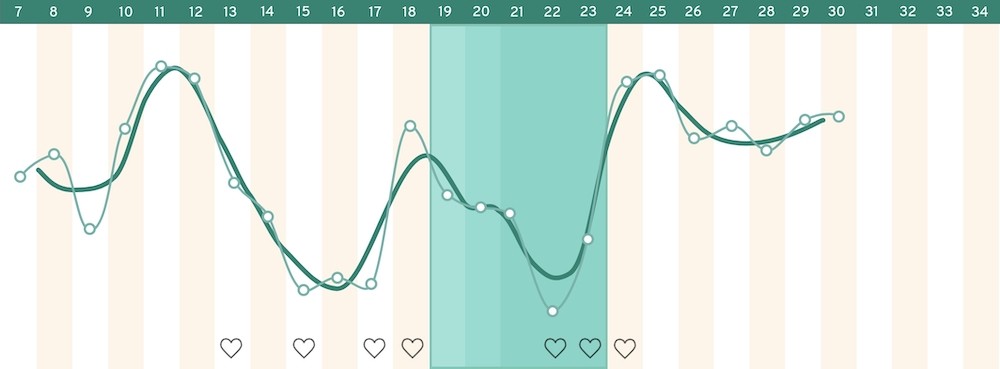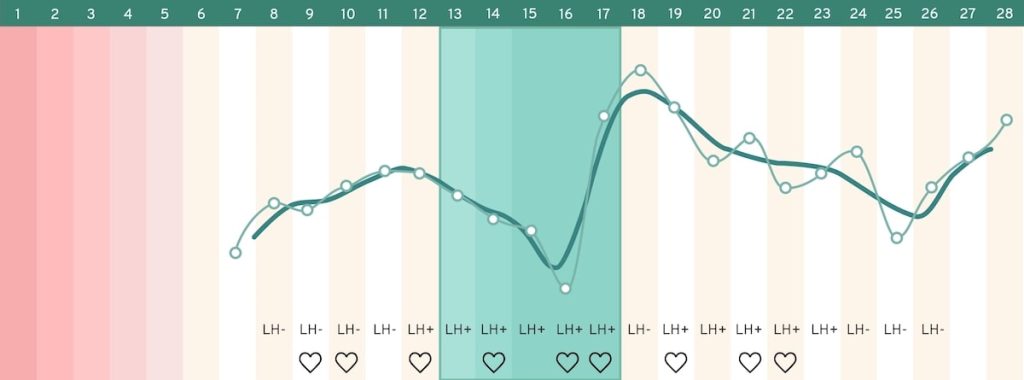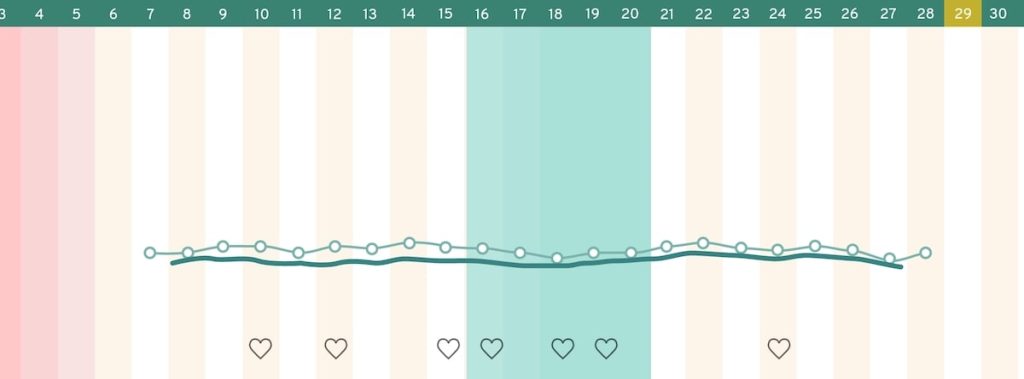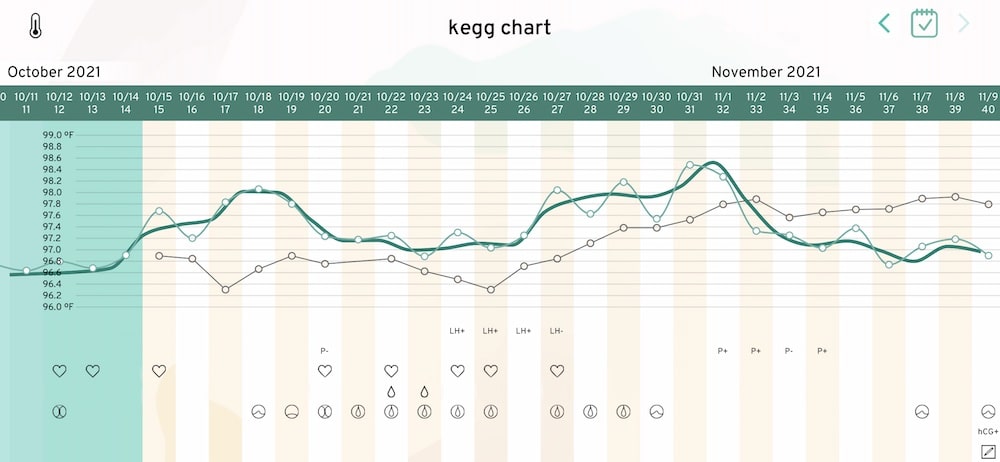There is a growing community of women with PCOS confidently tracking their fertility with kegg.
Each kegg reading reflects the cumulative electrolyte value in the cervical fluid. The electrolytes in the cervical fluid shift with the hormonal changes. The kegg readings tend to lower as the user enters the fertile window. This forms a potential “fertile valley” in readings. The lower readings are associated with a vaginal environment that is hospitable to sperm. In other words, readings that are low on the kegg chart suggest the user may be in the fertile window. Learn here how to read kegg charts.
In order to see a potential fertile window, the user must experience the hormonal changes that occur prior to ovulation. The increasing estrogen, for example, is associated with the descending kegg values and clues the kegg user into the opening of a potential fertile window.
While kegg predictions have not been clinically tested in women with PCOS, many women use kegg to track their cycles, monitor the trends of their cycles, identify their fertile windows, and ultimately feel in control of their fertility.
PCOS impacts women differently. While some women with PCOS ovulate fairly consistently and have regular periods, others may not ovulate without medical intervention, or they might ovulate inconsistently. For this reason, there is not one pattern of kegg trends consistent among all women with PCOS and these example PCOS charts demonstrate this.
kegg provides fertile window predictions for cycles 21-40 days in length. However, if a user’s cycles are highly irregular or if her cycles are longer than 40 days, she will watch her daily trendline data, and time sex on days with low readings.
In cycles where these hormonal changes do not take place and thus ovulation does not occur, Users will likely not see a definitive “fertile valley” in their kegg data. Alternatively, it is possible to record a fertile valley in kegg readings and for the body to experience these surging hormones but not successfully result in ovulation. While kegg cannot confirm ovulation, users with PCOS and/or irregular cycles, can optimally time their trying to conceive efforts with each potential fertile valley to ensure they are not missing out on a fertile day.
Since the electrolytes in the cervical fluid fluctuate according to the hormonal changes of the cycle, the kegg user can look for descending reading on their kegg chart to identify a potential fertile window. The kegg user can presume their fertile window is ending when they see a rise in kegg data, as the rise in progesterone results in a change in the electrolytes of the cervical fluid. As noted above though, kegg alone cannot confirm ovulation has occurred.
Given that PCOS presents differently among women, we have observed many different chart characteristics among kegg users with PCOS.
Some women with PCOS have observed what appears to be multiple fertile valleys in their kegg data. In this example the user purposefully timed her trying to conceive efforts during the dips or valleys assuming these valleys could be attempts at ovulation. A few days after her first valley and rise she found her trend line dropping again and decided to have sex on those days too just in case her first valley wasn’t successful in achieving ovulation. This was followed by an 11-day luteal phase. Her typical luteal phase is 11-12 days. If the first valley had been successful, her period would have come much sooner near cycle day 29, therefore this confirms the first attempt at ovulation was not successful.

PCOS 2a: Unreliable LH results
A classic feature of PCOS is multiple or sustained LH surges. This user noted in her chart when she had an LH surge. Note the two “dips” or valleys and the two positive LH test results, on CD 16-17 and CD 31.

PCOS 2b: sustained LH surge
Another common occurrence for women with PCOS is many days in a row with positive LH results. Without serum hormone testing and ultrasounds throughout the cycle, we cannot confirm when or even IF ovulation took place. In the chart below, you will notice this user had several days of a positive LH result. Her kegg results helped guide her, as she noted her readings continuing to descend, followed by a rise. She then had a typical 12-day luteal phase.

PCOS 4: flat trend line
A final pattern we have seen in some users with PCOS is very low and flat kegg data. Some users that have experienced “flat” kegg reading will have some very flat cycles and other cycles with more typical patterns. This cycle was likely anovulatory. But we have also seen cycles with flat data with confirmed ovulation and successful conception.

We have heard from happy mamas with PCOS who were able to successfully conceive using kegg.

This mama with PCOS conceived during her first kegg cycle. She shared “I am 34 with PCOS and I was using kegg to conceive my second child naturally. My first child was conceived after 3 years of trying, on our second try with fertility medication and I was hoping to avoid that this time. I know our main issue was timing and with OPKs I would get false positives so I searched for a different way and I came across kegg. I often had a hard time reading my own cervical mucus so I thought this would be great. I ordered it shortly before I found out that I did not get pregnant on our first cycle trying. I started using it on my second cycle. After going into a descent around cycle day 14, I did a Proov PDG test 7 days later to confirm and I did not ovulate yet. I kept doing my daily readings until I went into another descent around cycle day 25. My basal body temperature, my opk tests and my kegg readings all lined up and pointed to ovulation happening. A week later, I took a Proov test and confirmed, finally, I ovulated! With the help of kegg I was able to determine even on my first cycle when I was my fertile window. Without kegg, it would have basically been a shot in the dark. I would have never known I ovulated so late. Shortly after we tried that cycle, I had a doctor’s appointment where they told me I would most likely need the help of a Reproductive Endocrinologist to conceive again. However, to my utter shock, I took a test a few days later and I was pregnant! I truly feel like kegg is a wonderful device and without it, maybe I would’ve needed a Reproductive Endocrinologist but we did use it and we conceived naturally and I am so over the moon and so grateful for this product! I just had my 7-week sonogram and saw the heartbeat. Thank you kegg, I can’t thank you enough! We are so overjoyed.”
Trying to conceive with PCOS can be a challenging journey. With the added insights of kegg*, many women with PCOS have been successful.
*Please note: while many women with PCOS choose to use kegg, kegg has not been clinically tested in women with PCOS. kegg cannot be used to diagnose or treat any medical condition.
